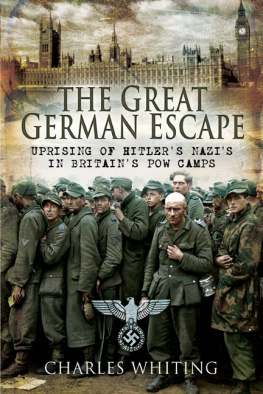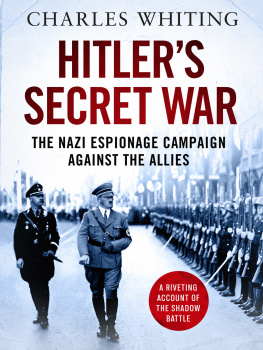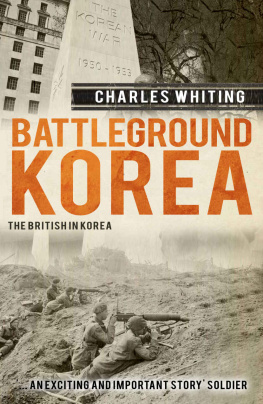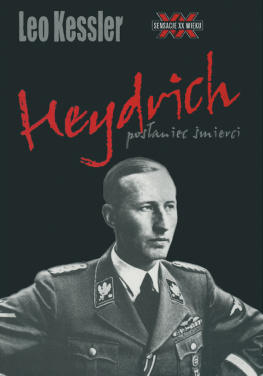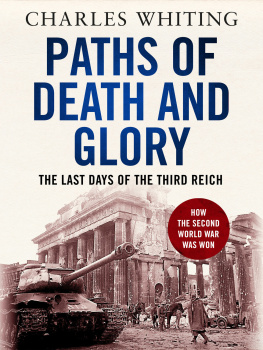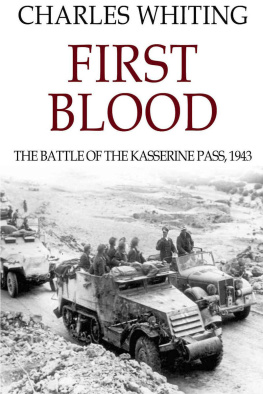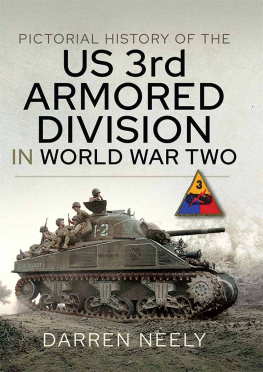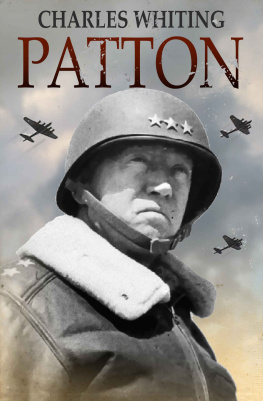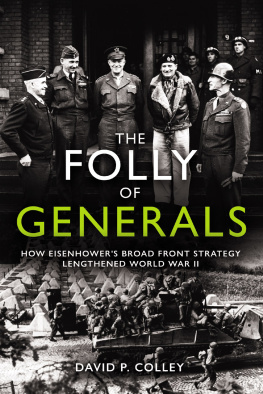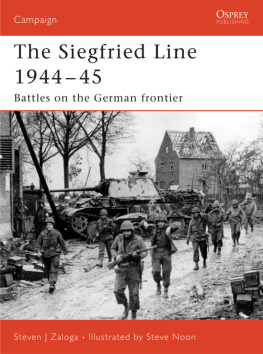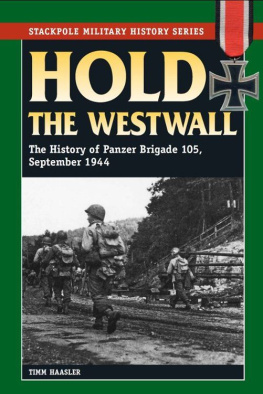Siegfried
The Nazis Last Stand
Charles Whiting
Charles Whiting 1982
Charles Whiting has asserted his rights under the Copyright, Design and Patents Act, 2001, to be identified as the author of this work.
First published in 1982 by Stein & Day, New York
This edition published in 2014 by Endeavour Press Ltd
Table of Contents
Soldiers of the West Front! I expect you to defend the sacred soil of Germany to the very last! Heil the Fhrer!
Field Marshal Gerd von Rumdstedt, 1944
The whole art of war consists of getting at what is on the other side of the hill.
The Duke of Wellington
Introduction
They are the men who, with their flesh and blood, buy victory. You can smash from the air, pound to rubble with artillery, thrust through with armor, but always these men on foot, the men with the rifles and bayonets and the steady slogging courage, must go on. Without them all else is in vain.
R.W. Thompson, March 1, 1945
It was boasted that the new National Socialist Empire, founded on January 30,1933, would last a thousand years. In fact it lasted a mere twelve years, four months and five days. Behind it, Hitlers vaunted 1,000 Year Reich left hardly anything tangible, apart from the geographical and political consequences of the most terrible war in history. With one exception. A lasting monument in concrete and steel: the great wall built by Hitler Der Westwall , which the Western Allies came to call the Siegfried Line.
Even today, forty years or more since that evil genius in Berlin ordered it to be constructed, the wall crawls across the German countryside from the Swiss border to the flat plains of Holland, past France, Luxembourg, Belgium, on and on for hundreds of miles like some obscene gray reptile. All its parts are still there, in spite of efforts made by the various Allied nations to destroy it during the war and in the years that followed. The holed military roads, the dragons teeth, the wrecked bunkers, the grotesquely twisted steel spars beneath the hedgerows stark weathered monuments to a terrible past, they will still be there when the last survivor of that impossible dream, the 1,000 Year Reich is long, long dead.
In the late thirties when it was being constructed, at tremendous expense and with a massive recruitment of labor from all over the Third Reich, Hitlers wall was regarded by some as the Fhrers great white elephant. For, they asked themselves, what useful purpose did it serve?
In Britain and America, this new gray concrete wall that had appeared so startlingly in the center of Europe was thought so amusing that it was made the subject of a comic song, which became one of the hits of 1939. For a long time afterward, first British and then American soldiers went to war singing that funny ditty about how they would soon hang their dirty washing on the Siegfried Line, if the Siegfried Lines still there. It was, and it is. Ironically, tragically, over a hundred thousand of those brave young men British, American, Canadian and French (for the ditty was translated into French too) marching so gaily away to war with that song on their lips, were fated to die before its steel and concrete defenses.
But whatever others might think about his new fortification line, Hitler knew it gave him the freedom of action in the East that he needed. For the first time in German history, due to the protection the Wall offered in the West, Germany did not have to fear a war on two fronts: the reason for her military downfall so often in the past. Thus the West Wall played a significant role in the events in Czechoslovakia and Poland in 1938/39.
The new Siegfried Line continued to deter the Western Allies through the winter and spring of 1939/40 while Hitler dealt with Poland, and when in the autumn of 1939 his peace offensive against the West failed, the Wall gave him time to plan the great attack westwards, which destroyed the French Army and sent the British reeling back to Dunkirk.
In 1940, Hitler no longer needed the Wall. Now, like Napoleon before him, he was master of all of Western Europe. For the next three years he extended that great empire of 300 million people until it stretched from Norway to North Africa and from the Channel to the Urals. The West Wall was abandoned to the wild life and the local farmers, its bunkers locked up and their keys lost, the guns removed to arm the new wall that Hitler was building on the Atlantic coast, the one that would stop the Western Allies dead if they ever attempted to invade his precious empire.
In September 1944 the West Wall came into its own again. Now, for the first time since it had been constructed, it was going to be tested as the khaki-clad tide of the advancing Allied armies who had already overcome the Atlantic Wall, swamping it with their strength, swept up against Germanys long frontiers. It would prove itself to be the impregnable fortification that Hitler had always maintained it was, even when manned by third-grade ear-and-nose battalions and stomach regiments all those Christmas Tree soldiers, as one of the first German defenders of the Wall General von Schwerin called them contemptuously. It stopped the Allied armies dead. For seven long months, British, Canadians, Americans and French, they all tried to break through it on four different national frontiers until the West Wall was finally swamped under sheer weight of numbers. It had prolonged the war by six months and the cost in Allied dead and wounded was higher than that suffered by the U.S. Army in the Korean and Vietnam Wars combined.
*
In a way it was Charlemagne, the great Frankish Emperor of the ninth century, who had caused all the trouble. Not in the way he lived, but in the way he died.
In spite of the fact that he was crowned Emperor by the Pope in Rome on Christmas Day 800, Charlemagne was still a pagan Frank in many ways. He could not read, he loved war and women (many of them) and he would not accept the ordained method of succession to his great empire stretching from Holland to Italy. The Church wanted him to leave it to his eldest son and thus keep the empire together. Charlemagne wanted his inheritance to be divided, as was the Frankish custom. Thus, when he died and was buried (according to legend, sitting upright on his great throne in Aachen), his son Louis the Pious was troubled for the rest of his days by his sons wanting a share of the Empire.
When Louis died the Frankish tradition triumphed. In 843 at the French city of Verdun, his three sons signed a treaty that was one of the most memorable documents of European history. By this treaty the great empire of their grandfather was divided into three parts. Charles the Bald gained the kingdom of the West Franks, which one day would be France. Louis the German acquired the East, which would develop into Germany. For his part, the eldest son Lothair retained the title of Emperor and a narrow strip of territory starting in Belgium and running down north-east into Burgundy. This barrier between the other two became known as Lotharingia. The uneasy frontier between the future France and Germany which would trouble Europe for the next thousand-odd years had been created.
From that day onward only two men would ever again rule over the combined territory of the Franks as Charlemagne had once done. Each would do so for only a short time and each would achieve his ambition by force of arms. One was a Frenchman, who wasnt really a Frenchman, for he was born of Italian stock in the island of Corsica: Napoleon Bonaparte. The other was a German, who wasnt a real German, for he only accepted German nationality in 1928 when he was already forty. His name was Adolf Hitler.
*
For over a thousand years the history of that unhappy frontier country, the one-time Lotharingia, could be compared to the working of an accordion. When France was strong, which was most of the time, the pressure was inward . When Germany was strong, less frequently, the pressure was outward .
Next page

